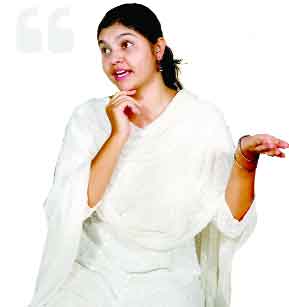Dastango Nusrat Ansari, through Dastan Alice Ki, presents Alice in a way that she is a dreamer and digs her own path through her struggles rather than being seen as an escapist. By Team Viva
Imagination has no restrictions. Who would know this better than Lewis Carroll? When Alice stepped through the looking glass one summer afternoon and fell down a rabbit hole, a tale replete with mystery, magic, twisted poetry, rhymes, confusion and logic came to the fore, where rabbits could talk and caterpillars would smoke hookah.
As artists Nusrat Ansari and Ainee Farooqui present the classics — Alice in the Wonderland and Through the Looking Glass — through the art of dastangoi, Nusrat explains how the duo brought out Alice’s story’s essence through the art form. She says, “Dastangoi has been picking up a lot recently. It’s written in a way that it naturally brings out the essence of a story. It is such a natural art form that it stays alive within the audience too as much as the performers.”
She says the art form involves a lot of improvisations and voiceovers, since this time they had kept it very interactive as well. But how? Nusrat explains with an instance, “When Alice has to guess the age of the queen, she tries to transfer the questions to the audience. So this way it is interactive. And it was so good to see that the audience was also actively participating in giving the answers and making the guesses.”
The artist says that such classics remain timeless and ever-relevant, and hence are narrated time and again. Hence, while Carroll’s classics had been penned in the 19th century, they remain relevant and ever-engrossing even today.
There are multiple interpretations of a character. When it was first presented by dastangos Poonam Girdhani and Ankit Chadha, they had their own interpretation of her, she says. Chadha had once said that the reason he chose Alice’s stories to begin their work for children is because her adventures are tilismi (magical) in nature, and the flavour of fantasy is similar to what they find in traditional dastans. Nusrat says, “My understanding and interpretation of Alice is that she is a very smart woman and one of those who knows that they are smart people. Even though she is being called an escapist and a lonely person, I see her as someone who finds her own way through her struggles, is a dreamer and believer, and has vivid ideas and imagination. She is a strong woman who can find out her ways.”
The dastan, based on Carroll’s classics, starts with Alice entering the fantasy land and discovering the world through the looking glass. After her size changes multiple times, Alice begins her journey on the chessboard to become a queen.
Talking about how the art form has evolved over the years, which had lost its charm among the audience in the late 1920s and brought back to life by Mahmood Farooqui during 2005. “People were amazed by what they saw and wanted to continue it after that. They saw it as an art form and an engaging form of storytelling.”
This is the first time, she says, that the classic is being presented even to the adults when it is mostly labelled as children’s tales or literature. “We did not just focus on children but kept in mind the adult audience too. And even they were equally engaged throughout.”
Writer: Team Viva
Courtesy: The Pioneer








 OpinionExpress.In
OpinionExpress.In















Comments (0)